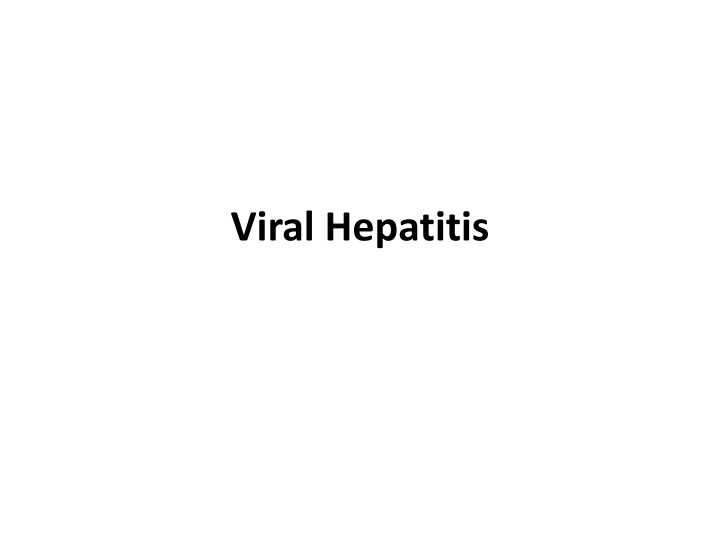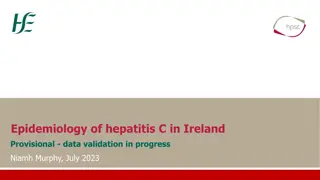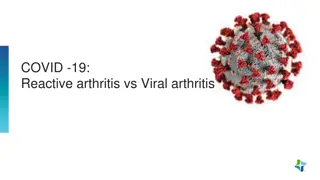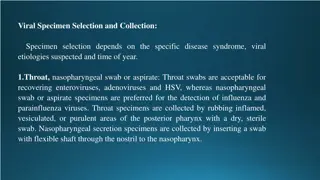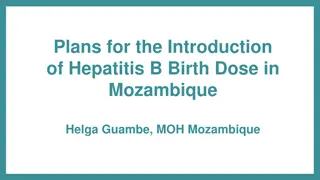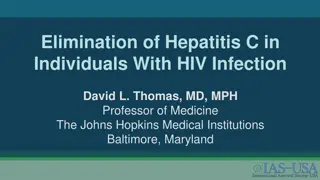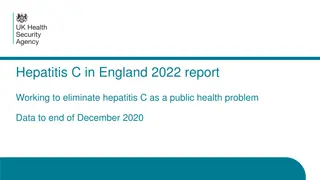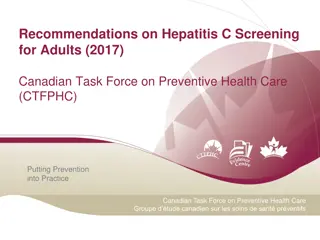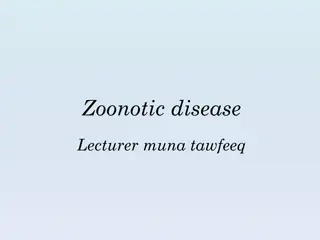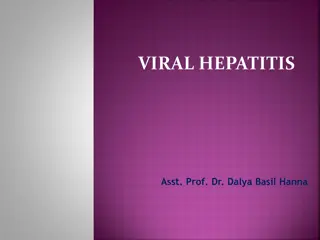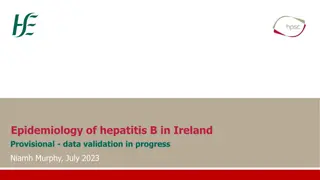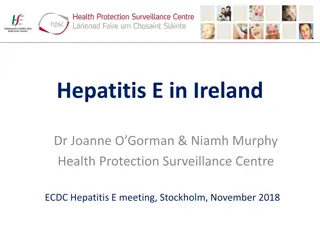Viral Hepatitis
Acute hepatitis, or liver inflammation, can be caused by various infectious and noninfectious agents. Viral hepatitis A to G differ in characteristics, transmission, and severity. Hepatitis A is common in children due to fecal-oral transmission, while hepatitis B and C can lead to chronic infection. Clinical manifestations include jaundice, hepatomegaly, and fever, with extrahepatic symptoms possible. Understanding the etiology, epidemiology, and clinical features of viral hepatitis is crucial for effective management and prevention.
Download Presentation

Please find below an Image/Link to download the presentation.
The content on the website is provided AS IS for your information and personal use only. It may not be sold, licensed, or shared on other websites without obtaining consent from the author.If you encounter any issues during the download, it is possible that the publisher has removed the file from their server.
You are allowed to download the files provided on this website for personal or commercial use, subject to the condition that they are used lawfully. All files are the property of their respective owners.
The content on the website is provided AS IS for your information and personal use only. It may not be sold, licensed, or shared on other websites without obtaining consent from the author.
E N D
Presentation Transcript
Etiology Acute hepatitis, or liver inflammation, can be the result of a number of infectious and noninfectious etiologies. The six primary hepatotropic viruses, hepatitis A to G, differ in their virological characteristics, transmission, severity, likelihood of persistence, and subsequent risk of causing hepatocellular carcinoma . The cause of 10-15% of cases of acute hepatitis is unknown.
Epidemiology Hepatitis A virus (HAV) is the most common cause of acute viral hepatitis and is spread by fecal-oral transmission. HAV is common in children globally, especially in areas of poor sanitation. Hepatitis B virus (HBV), hepatitis C virus (HCV), and hepatitis D virus (HDV) infections can result in chronic hepatitis, or a chronic carrier state, which facilitates spread. HDV, also known as the delta agent, is a defective virus that requires HBV for spread and causes either coinfection with HBV or superinfection in chronic carriers of hepatitis B surface antigen (HBsAg). Routine vaccination has also been effective in reducing the rates of HBV infection, especially in children. The major risk factors for HBV and HCV are injectable drug use, frequent exposure to blood products, and perinatal transmission from maternal infection. Hepatitis E virus (HEV) infection occurs following travel to endemic areas (South Asia) outside of the United States. Hepatitis G virus (HGV) is prevalent in HIV-infected persons. HBV and HCV cause chronic infection, which may lead to cirrhosis and hepatocellular carcinoma and represents a persistent risk of transmission.
Clinical Manifestations Jaundice Hepatomegaly Fever Without a Source Asymptomatic or mild, nonspecific illness without icterus is common with HAV, HBV, and HCV, especially in young children. When present, symptoms of acute infection are difficult to distinguish between these viruses. Younger children are often asymptomatic when infected with HAV, HBV, and HCV. Fulminant HAV infection is rare, and chronic infection does not occur. In acute HBV infection the likelihood of symptoms increases with age, ranging from 1% of infants <12 months of age to 30-50% of people >5 years. In HBV infection, the preicteric phase, which lasts approximately 1 week, is characterized by headache, anorexia, malaise, abdominal discomfort, nausea, and vomiting; it usually precedes the onset of clinically detectable disease.
Extrahepatic manifestations such as arthralgia, arthritis, rash, thrombocytopenia, glomerulonephritis, or papular acrodermatitis (Gianotti- Crosti syndrome) can occur early in the illness. Jaundice and tender hepatomegaly occur later and characterize the icteric phase. Prodromal symptoms, particularly in children, may abate during the icteric phase. Hepatic enzymes may increase 15- to 20-fold. Resolution of the hyperbilirubinemia and normalization of the transaminases may take 6-8 weeks.
Laboratory and Imaging Studies Alanine aminotransferase (ALT) and aspartate aminotransferase (AST) levels are elevated and generally reflect the degree of parenchymal inflammation. Alkaline phosphatase and total and direct (conjugated) bilirubin levels indicate the degree of cholestasis, which results from hepatocellular and bile duct damage. The prothrombin time is a good predictor of severe hepatocellular injury and progression to fulminant hepatic failure . The diagnosis of viral hepatitis is confirmed by serological testing . The presence of IgM-specific antibody to HAV with low or absent IgG antibody is presumptive evidence of acute HAV infection.
The presence of HBsAg signifies acute or chronic infection with HBV. Antigenemia appears early in the illness and is usually transient but is characteristic of chronic infection. Maternal HBsAg status should always be determined when HBV infection is diagnosed in children younger than 1 year of age because of the likelihood of vertical transmission. Hepatitis B early antigen (HBeAg) appears in the serum with acute HBV. The continued presence of HBsAg and HBeAg in the absence of antibody to e antigen (anti- HBe) indicates high risk of transmissibility that is associated with ongoing viral replication. Clearance of HBsAg from the serum precedes a variable window period, followed by the emergence of the antibody to surface antigen (anti-HBs), which indicates development of lifelong immunity and is also a marker of immunization. Antibody to core antigen (anti-HBc) is a useful marker for recognizing HBV infection during the window phase (when HBsAg has disappeared but before the appearance of anti-HBs). Anti-HBe is useful in predicting a low degree of infectivity during the carrier state.
Seroconversion after HCV infection may occur 6 months after infection. A positive result of HCV enzyme-linked immunosorbent assay (ELISA) should be confirmed with the more specific recombinant immunoblot assay, which detects antibodies to multiple HCV antigens. Detection of HCV RNA by polymerase chain reaction (PCR) is a sensitive marker for active infection, and results may be positive just 3 days after inoculation
Differential Diagnosis Many other viruses may cause hepatitis as a component of systemic infection, including Epstein Barr virus, cytomegalovirus, varicella- zoster virus, herpes simplex virus, and adenoviruses. Bacterial sepsis can also cause hepatic inflammation and dysfunction. Patients with cholecystitis, cholangitis, and choledocholithiasis may present with acute symptoms and jaundice. Other causes of acute liver disease in childhood include drugs (isoniazid, phenytoin, valproic acid, carbamazepine, oral contraceptives, acetaminophen), parenteral nutrition, toxins (ethanol, poisonous mushroom), Wilson disease, metabolic disease (galactosemia, tyrosinemia, mitochondrial disorders), 1-antitrypsin deficiency, tumor, shock, anoxia, autoimmune hepatitis, hemophagocytic syndromes, and graft-versus-host disease .
Treatment The treatment of acute hepatitis is largely supportive and involves rest, hydration, and adequate nutrition. Hospitalization is indicated for children with severe vomiting and dehydration, a prolonged prothrombin time, or signs of hepatic encephalopathy. When the diagnosis of viral hepatitis is established, attention should be directed toward preventing its spread to close contacts. For HAV, hygienic measures include hand washing and careful disposal of excreta, contaminated diapers or clothing, needles, and other blood-contaminated items. The treatment of chronic HBV and HCV infections is evolving with the development of new antivirals. The decision to treat is based on the patient's age, viral genotype, and stage of viral infection.
Complications and Prognosis Most cases of acute viral hepatitis resolve without specific therapy, with less than 0.1% of cases progressing to fulminant hepatic necrosis. HAV and HEV cause acute infection only. HBV, HCV, and HDV may persist as chronic infection, with chronic inflammation, fibrosis, and cirrhosis and the associated risk of hepatocellular carcinoma. From 5 to 10% of adults with HBV develop persistent infection, defined by persistence of HBsAg in the blood for more than 6 months, compared with 90% of children who acquire HBV by perinatal transmission. Chronic HBsAg carriers are usually HBeAg-negative and have no clinical, biochemical, or serological evidence of active hepatitis unless there is superinfection with HDV. Approximately 10-15% of HBsAg carriers eventually clear HBsAg. Approximately 85% of persons infected with HCV remain chronically infected, which is characterized by fluctuating transaminase levels . There is poor correlation of symptoms with ongoing liver damage. Approximately 20% of persons with chronic infection develop cirrhosis, and approximately 25% of those develop hepatocellular carcinoma. HIV infection and ethanol use increase the risk of HCV progression.
Prevention Good hygienic practices significantly reduce the risk of fecal oral transmission of HAV. HAV vaccine is recommended for routine immunization of all children beginning at 12 months. Unvaccinated household and sexual contacts of persons with HAV should receive postexposure prophylaxis as soon as possible and within 2 weeks of the last exposure. A single dose of HAV vaccine at the age-appropriate dose is preferred for persons 12 months to 40 years of age. Immunoglobulin (0.02 mL/kg) given intramuscularly (IGIM) is preferred for children under 12 months of age, persons over 40 years of age, and immunocompromised persons. For preexposure prophylaxis, unvaccinated travelers to endemic regions who are 12 months of age or older should also receive a single dose of HAV vaccine administered at any time before departure. Infants <12 months of age, older adults, immunocompromised people, or those with chronic liver disease or other chronic medical conditions can receive IGIM along with the HAV vaccine dose to optimize protection. This regimen can also be considered for travel <2 weeks in the future.
HBV vaccine is recommended for routine immunization of all infants beginning at birth and for all children and adolescents through 18 years of age who have not been immunized previously . It is also recommended as a preexposure vaccination for older children and adults at increased risk of sexual, percutaneous, or mucosal exposure to HBV as well as those with chronic liver disease, human immunodeficiency virus (HIV), and travelers to areas of endemic HBV infection. Infants born to HBsAg-positive mothers should receive HBV vaccine and hepatitis B immunoglobulin (HBIG; 0.5 mL) within 12 hours of birth, with subsequent vaccine doses at 1 and 6 months of age followed by testing for HBsAg and anti-HBs at 9-15 months of age. Infants born to mothers whose HBsAg status is unknown should receive vaccine within 12 hours of birth. If maternal testing is positive for HBsAg, the infant should receive HBIG as soon as possible (no later than 1 week of age). The combination of HBIG and vaccination is 99% effective in preventing vertical transmission of HBV. Vaccination alone without HBIG may prevent 75% of cases of perinatal HBV transmission and approximately 95% of cases of symptomatic childhood HBV infection.
Postexposure prophylaxis of unvaccinated persons using HBIG and vaccine is recommended following needle-stick injuries with blood from an HBsAg- positive patient and for sexual or needle-sharing contacts or victims of sexual abuse by an HBsAg-positive person. The screening of blood donors significantly reduces the risk of blood-borne transmission.
